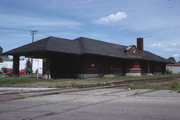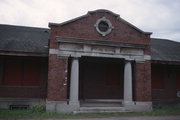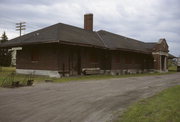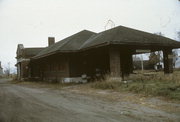Property Record
RAILROAD ST
Architecture and History Inventory
| Historic Name: | CHICAGO & NORTHWESTERN RAILROAD DEPOT |
|---|---|
| Other Name: | CHICAGO & NORTHWESTERN RAILROAD DEPOT |
| Contributing: | |
| Reference Number: | 29077 |
| Location (Address): | RAILROAD ST |
|---|---|
| County: | Sauk |
| City: | Reedsburg |
| Township/Village: | |
| Unincorporated Community: | |
| Town: | |
| Range: | |
| Direction: | |
| Section: | |
| Quarter Section: | |
| Quarter/Quarter Section: |
| Year Built: | 1905 |
|---|---|
| Additions: | |
| Survey Date: | 1977 |
| Historic Use: | depot |
| Architectural Style: | Neoclassical/Beaux Arts |
| Structural System: | |
| Wall Material: | Brick |
| Architect: | FROST AND GRANGER; Charles W. Gindele (Builder) |
| Other Buildings On Site: | |
| Demolished?: | No |
| Demolished Date: |
| National/State Register Listing Name: | Chicago and North Western Depot |
|---|---|
| National Register Listing Date: | 12/26/1984 |
| State Register Listing Date: | 1/1/1989 |
| National Register Multiple Property Name: | Multiple Resources of Reedsburg |
| Additional Information: | A 'site file' exists for this property. It contains additional information such as correspondence, newspaper clippings, or historical information. It is a public record and may be viewed in person at the Wisconsin Historical Society, Division of Historic Preservation. Architectural Statement: Wide eaves; wood braces with stone corbels; windows boarded; portico with two large limestone columns with entablature. The Chicago and North Western depot is a one story hip roof structure of pressed red brick with scored Bedford limestone trim. It was built with a pile foundation driven into the sandy loam. The hip roof was covered with slate and had had a metal ridge but now has asphalt shingles; the enclosed section is approximately 119 1/2' x 29 1/2' with an open platform on the west, adding another 20' in length to the depot. The wide eaves are supported by wood braces with stone corbels. Although windows are now borded over, they were 8/1 and 6/1 with "obscure glass" (G). A tall brick chimney with a stone cap is on the south slope of the roof. Windows have stone sills and most openings have cast iron lintels (G). The facade facing Railroad Street has a central portico entry with a stone coping and circular design with four keystones. The sides of the entry have semi-circular brick arches with stone keystones. Two heavy fluted stone columns with an entablature stretching between them are the chief features of the portico. Wood double doors with panels lead into the vestibule. The west side of the depot has a roofed platform with open sides and a brick floor. The wood platform which once surrounded the entire depot is now gone. The south side of the depot faces the tracks and has a bay window centered on it (directly opposite the main entry). A pediment identical to the front entry is above the bay. The same type windows and doors on the front are also found on this side, although some of the doors appear to have had windows in the top section and an overlight (G-now boarded). The entry to the baggage room is made in the east part of the depot from the track side. The double doors to this section are different from others, having diagonal wood patterns in the panels. The baggage room interior walls are brick. The stairway to the basement is also found on this side of the depot. The basement, only accessable from the outside, once housed the heating system and coal storage, but is empty today. Basement windows provide a lot of natural light in this area. East of the vestibule are the smoking room and mens' toilet. To the west is the main waiting room, womens' toilet and railway express area. Radiators were under many windows. The floor is 6" concrete with tile laid to resemble marble. The mop board is concrete with 4' oak wainscoating over it and the ticket office, behind the bay window, is quarter sawn oak. The metal grid over the ticket counter is still extant. When the depot was built all metal fixtures and hinges were bronze and the interior doors were white pine with self closing springs (H). Woodwork was heavily varnished. The steam heating system was put in by W.H. Zech and the interior finishing was done by N.A. Cushman, both of Reedsburg. When the depot opened in January, 1906, the "Reedsburg Free Press" noted that "everyone pronounces it too low and remarks on the `squatty' appearance, but this is all forgotten when once inside" (I). Much of the interior remains as it was when it was built, although it was hard to see if the brass fixtures and original doors still exist because the building has no electricity. Telegraphy, ticket equipment, some passenger waiting benches and desks are stored in the building. The depot has maintained a high degree of integrity inside and outside. Architectural Statement of Significance: The Chicago and North Western depot is an architecturally significant example of twentieth century railroad depot design. The Chicago and North Western depot's elongated appearance is broken by a well porportioned Classical Revival portico. Although the depot is in need of repairs, it has retained much of its interior and exterior design integrity. It is an asset to the cultural resources of Reedsburg. The depot was designed by Frost and Granger, a Chicago architectural firm that built many C & NW depots, including their main terminal (North Western Station) and the LaSalle Street Station (Rock Island and New York Central) in Chicago (F). Frost was born in Maine and studied architecture at MIT. He and Granger formed a partnership from 1898-1910. After his marriage to the daughter of a railroad magnate in 1885, he received numerous commissions to design railroad buildings. Granger was born in Ohio and educated at MIT, as well as at the Ecole des Beaux Arts in Paris. Smaller depots designed by Frost and Granger in Wisconsin include those in South Milwaukee, Oconomowoc, Wausau, Ashland, Fond du Lac, Rhinelander, Superior, and Eau Claire (K). Charles W. Gindele of Chicago was the contractor. Historical Statement: Although an early settler in Reedsburg wrote in 1849 that "the question of building a railroad from Milwaukee to Prairie LaCrosse on the Mississippi River by way of Fort Winnebago and Baraboo Valley had been talked of a good deal lately and will probably be accomplished in a few years", his optimism proved unfounded (A). Several attempts in the 1850s and 1860s to establish railroad service through Reedsburg failed. Lack of local financing or disapproval from state and federal agencies caused these first efforts to falter. In December, 1869 Colonel S.V.R. Ableman of Rock Springs, an early railroad advocate, was named as the chairman of another committee to draw up a railroad charter. The group met in Baraboo and Joseph Mackey and R.M. Strong of Reedsburg were included on this committee that finally succeeded in bringing railroad transportation to Reedsburg. The resulting Baraboo Air Line Railroad Charter was approved by the legislature in March, 1870. A special election was held in Reedsburg to vote on $25,000 for bonds that same year (C). Both the Chicago and North Western and Michigan Central Railroad Companies showed interest in building the line. The Chicago and North Western Line agreed to build the tracks and reached Baraboo in September, 1871 and Reedsburg in January, 1872 (C). A frame depot was soon built in the south section of town and the area began to develop. The 1902 directory advertised Reedsburg as "situated on the C & NW Railroad, midway between Chicago and St. Paul. It affords most excellent opportunities both for shipping and receiving goods and nine passenger trains daily besides two accommodation freight trains furnish the best facilities for travel" (D). In 1905 railway officials from the Madison Division of the Chicago and North Western Railroad visited Reedsburg to look for an appropriate site for a new $30,000 passenger depot (E). They decided to build on the site of the existing depot. The original frame depot was moved and used as a freight depot (until demolished in 1961). Reedsburg continued to be on one of the main lines from Chicago to St. Paul until about 1920, but rail service gradually dwindled. Passenger service stopped in 1963 and freight trains are irregular. The building is no longer used and is presently for sale (J). Historical Statement of Significance: The Chicago and North Western depot has local historical significance because of its association with the development of transportation in Reedsburg. The railroad arrived in Reedsburg in 1872, as a part of the main line from Chicago to St. Paul, a primary reason the city developed in the late nineteenth century as a trade and market center for the surrounding agricultural area. In 1905 when the current depot was built, and for many years after, the railway was the main form of transportation and served passengers and freight until 1963. The Chicago and North Western depot is the only extant building that is a physical representation of this. |
|---|---|
| Bibliographic References: | PLANS. A- Reedsburg Centennial Committee, Reedsburg Remembers (Historical Committee, Reedsburg Centennial, 1948); this information is from a letter by S.J. Seymour dated February 3, 1849. B- French, Bella Mrs. (ed.), History of Reedsburg, Wisconsin 1875, an issue of The American Sketchbook, (LaCrosse, Sketchbook Company, 1875). Dwinnell, Solomon A., Sauk County, Town of Reedsburg. This was written in 1872 and reproduced by Donald V. Hyzer, Reedsburg in 1890. It is the same as Sketch No. 6 of W.H. Canfield's Sketchbook of Sauk County, Wisconsin, Baraboo. Sketches were written between 1861-1890 and later bound. C- Gregory, John G (ed.), Southwestern Wisconsin: A History of Old Crawford County, Vol. II (Chicago, S.J. Clark Publishing Company, 1932). D- Schuette, W.J. and Freer, Theo., Reedsburg Directory (Reedsburg, Free Press Printing House, 1902-1903). E- Krug, Merton E., History of Reedsburg and the Upper Baraboo Valley (Madison, Democrat Printing Company, 1929). F- Michael W. Payette, Assistant Vice-President for Public Affairs, C & NW Transportation Company, March, 1984. G- Plans and Elevations from the C & NW Transportation Company. H- "The Reedsburg Times", July 21, 1905 & December 1, 1905. I- "Reedsburg Free Press", January 25, 1906. J- C & NW agent, Doug Hansen, Baraboo, March, 1984. K- RP3, Architecture Study Unit. Reedsburg Times Press 10/24/1998. |
| Wisconsin Architecture and History Inventory, State Historic Preservation Office, Wisconsin Historical Society, Madison, Wisconsin |





